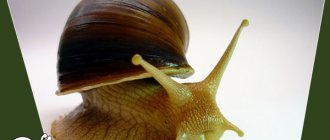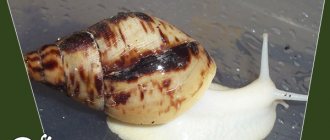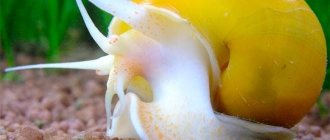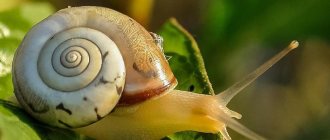Chemical burn and poisoning
When burned or poisoned by chemicals, 96% of individuals die. Contact with harmful substances
possible in the following cases:
- the food that came into the bowl was treated with pesticides;
- the owner did not wash the ulitharium well after cleaning it;
- salt got into the house, which is harmful to the mollusk.
If the breeder notices that the shell is foaming and bubbling, and the body is covered with white mucus, you can try to save the pet. To do this, Achatina should be washed under water. If this does not help, then death is inevitable. In this case, the best option is to put the animal in the cold. There it will die in its sleep, without suffering.
You can avoid chemical exposure by thoroughly washing the soil and rinsing the aquarium. You should not resort to the use of chemicals to clean the house, and the snail itself should not be released outside of it unnecessarily.
Snail falling out of shell
As we wrote above, the shell is part of the snail, and problems with it will inevitably affect the health and condition of your unusual pet. And now we will look at the most serious of them.
Causes of a snail falling out of its shell
Complete or partial loss of a snail from its shell is a real nightmare for the owner of a mollusk. One day discovering your snail has left its shell is truly scary. This can happen due to failure to comply with the correct conditions for keeping the pet (about keeping Achatina at home), due to stress received by the snail, due to a genetic predisposition to such an anomaly, as a result of frostbite and prolonged exposure to low temperatures, and as a result of bacterial or infectious infection.
Treatment for a snail falling out of its shell
This is what it looks like when a snail completely falls out of its shell.
Unfortunately, such a violation is too serious to be simply ignored, and it is not so easy to correct. However, you shouldn’t give up prematurely and say goodbye to your snail. You have to fight for it - who knows, maybe you will succeed. The main thing is to follow our instructions.
So, if your snail has partially or completely fallen out of its house, carefully place it in a separate snail. Now her relatives can easily harm her, and she will not be able to hide from them in her shell. With clean hands, try to carefully push the snail into its shell - given the spiral-shaped structure of the shell, this is not so easy, but you can try. After you have managed to push the snail into the shell at least a little (every millimeter is important - perhaps it is your efforts that will give the snail a push and then it will pull itself into the shell on its own), dilute ½ tablet of mitronidazole (125 milligrams) in a glass of warm boiled water and Carefully bathe the snail in this solution, making sure that the mollusk does not choke.
After such a life-saving water procedure - it should kill bacteria and infections on the surface of the snail’s body, place the sick pet in a low-walled uterus, but instead of the usual soil as a filler, lay a damp, clean towel or cloth (lint-free)
Next, you will need to ensure the required temperature and optimal humidity level in the mini ulitaria - the latter is very important, since drying out the snail’s body will lead to its death. Now you can only hope that your snail will cope and get better
In the history of keeping Achatina and grape snails at home, there are cases with a happy ending, when snails successfully recovered even after such a seemingly fatal diagnosis as snail loss.
If your pet is lucky, try not to pick it up by the shell in the future, and especially not to lift the snail by its shell, so as not to disrupt the integrity of the muscles connecting the snail’s body to the shell.
Video about snails at home
Today we looked at a very serious topic for snail breeders - the possibility of a snail living without a shell, and first aid for a snail that has lost part or all of its shell. We hope that this will not happen to your pet, but if the situation does occur, you will not be confused and will know how to help your snail.
We will be interested to hear about your stories of treating and saving your snails, and, of course, do not forget to post photos of your pets on the pages of our VKontakte group.
We are waiting for your feedback and comments, join our VKontakte group!
Diseases of gastropods - causes of death of delicate pets
To understand how and why Achatina snails can die, you need to understand the most common snail diseases. Most ailments arise due to the breeder’s oversight and uncomfortable conditions in the uterus.
But it happens that the owner breaks his head, blames himself and is sad about the dead Achatina snail, but it is not the owner’s fault. Achatina may die due to genetic diseases that cannot be cured or prevented.
Sink problems
- The most common cause of snail death is a broken shell. Due to the owner's carelessness, pets fall out of containers and fall onto hard surfaces. The result is cracks of varying sizes, chipped apex, holes in the shell and broken growth. If you take proper measures in time, the snail will most likely die.
- The second common problem is shell delamination. This happens due to poor living conditions or due to a genetic disease. Modifications to the shell occur due to the stressful state of the snail. Perhaps she doesn’t like the soil, isn’t happy with the food, or is depressed by the neighborhood. If the conditions for the mollusk are ideal, but the shell still stands, then this is a genetic disease that will lead to the irreversible death of Achatina.
- White plaque on the shell occurs from constant friction against some objects, due to illiterate maintenance or as a result of aging of the snail. In nature, African Achatina live 7-10 years, but in captivity this figure can be reduced by 2 times. The old snail is turning gray and you can only make it easier for her to die soon.
- Thermal and chemical burns are often found in delicate and defenseless Achatina. Owners do not wash their hands before petting their pets, and a wide variety of harmful substances can remain on the skin: grains of salt, pepper, particles of detergent. There have been cases when owners, while doing housework, cooking or cleaning, can accidentally stroke Achatina out of emotion. Then they are surprised to observe dark spots and unsightly changes on the skin, due to which the pet can also die.
Eating problems
- One of the most common causes of death in domestic Achatina is food poisoning. Owners buy fruits and vegetables in supermarkets and markets, do not wash them well enough, and do not check them for high levels of fertilizers.
- Eating one's own shell or a neighbor's shell is a common occurrence among African Achatina. The main causes of this disease are the pet’s deep stress, lack of calcium or genetic predisposition. In the first cases, you can correct the situation by transplanting the pet and changing the living conditions; in the case of a congenital disease, it is almost impossible to help the animal and it will most likely die.
- The loss of the internal and genital organs of a snail is very frightening for inexperienced breeders, because even a child understands that the snail can die from this. It has been noticed that this phenomenon occurs due to chemical poisoning by drug vapors, due to hypothermia or a sudden change in living conditions. Breeders try to set prolapsed organs, but this is not always successful. The adult individual copes with the problem itself and draws in its fallen “spare parts.” But if the situation is not corrected in time, then most likely the sick Achatina will die.
To know exactly why Achatina snails die, you need to constantly expand your knowledge about gentle African beauties. Any creature living under the care of its owner requires close attention and careful care. Knowing the signs of death of Achatina snails is not very pleasant, but necessary for every breeder.
Snail in an aquarium
The horned snail is perfect for populated aquariums where there are no predatory fish, such as loaches, large cichlids, macropods, and Helena snails. Clithon corona are social animals, so they must be introduced into the aquarium in numbers of at least five individuals. Bumblebee Nerites have a peaceful nature and do not offend other inhabitants of the aquarium, nor do they damage plants. You can plant any plants in the aquarium; these mollusks will not touch them, but, on the contrary, will help get rid of the accumulation of various algae on their leaves. Horned clams only eat dead or decaying matter.
Clithon corona is excellent at cleaning aquarium walls, driftwood and plants from organic waste and algae. Due to their size, these little ones can get into places that are difficult for most aquarium inhabitants to reach and clear algae there. Horned snails are very light and can sit on small and thin leaves of aquarium plants.
The sink has cracked, what should I do? (((
My children are delighted with it. Colorful, kind and teaches good things to our children. Unlike Western ones." Added -
Littleone 2009-2012 > Hobbies and interests > About pets > Achatina broke his shell, help!
View full version: Achatina broke his shell, help!
I wrote in a thread about snails, but no one has responded yet. What to do? There was no injury, the shell just began to crumble, and the snail kept breaking it all night. Only the upper half of the shell remained, and all morning the snail lay there, torn to pieces, with a dying look. And now she is NAKED with a small piece of shell on top, cheerfully cutting through the aquarium. But she can’t live like that. Can she still be saved?! The shell was always fragile, although I kept adding crushed calcium gluconate. And yet, for some reason this snail always preferred the mold that grew on them to bananas and any vegetables. Is this even normal? Is there anything I can do for the poor animal?
Go to the topic about snails https://www.forum.littleone.ru/showthread.php?t=223373 maybe they will help the animal there...
I wrote in the topic this morning, but no one has responded yet. the veterinarian told me to keep the body moist, but nothing else... and that she clearly has metabolic abnormalities, since she only likes mold, and that calcium gluconate should be replaced with chalk or shells. But this is not emergency help.
It's better to have a cuttlefish shell than chalk
and where can I get this?
I buy shell (Sepia) at a pet store, but in the parrot food department, be prepared for the fact that they won’t answer the question of where you have sepia or cuttlefish shell, I’ve already encountered this.
Where do the snails go?
I'm bringing up a pressing issue! I don't have snails! It’s not that I dreamed of having them, it’s just strange where they go. Each time I come across different snails with the plants, but I don’t observe them for long. I got some Pokemon, I have 5 pieces of 1 cm each and 2 pieces of 3 mm each, so I’m afraid to put them in a common aquarium - they’ll disappear! They are still sitting with the little picilians in the hatchery (the hatchery floats right in the aquas, it has holes), nimble (snails) and healthy, 3 coils are still sitting there, all the walls of the aquarium are already in the clutches of their eggs, but there are no snails in the aquas. I put away these coils when they gave me the hornwort, there were a lot of them, the person who gave it even apologized. Of the fish I have livebearers, 2 glass catfish, a pair of zebra loaches, a bird (18 cm), chanterelles, 5 small ancistrus - 3 cm (they live with me for only a few days, I recently acquired them) that's the whole modest set. Which of my people eats them? The water is clean, there are no deposits, the plants are in order (there are also dying leaves, but within normal limits), the fish are not starving, they reproduce periodically. Who thinks about this? I repeat once again - I’m not a snail fanatic, but I would like to have Pokemon, for example. I'm wildly sorry, not the coils, but the melania.
Yesterday I decided to throw the melania into the general aquatic tank, but the fry and eggs remained in the hatchery for now, so today I found one dead. the young ones are fine. They have the same water! What should I do? Maybe the bird eats them?
138 Moscow 5 years
Perhaps the bots eat them?
266 7 Moscow 7 months.
I mean, it’s dead, if the shell is empty, then someone ate it, and if the snail seems to have been thrown out of the house and no one is touching it, then maybe there’s something wrong with the water, by chance the fish haven’t been treated lately. Most likely the bots are nibbling on them, get a lot, a lot of coils, and you will provide the bots with good food and they will reproduce faster than they eat. By the way, don’t forget to occasionally collect empty shells from the bottom)
Swelling of the mantle
The mantle is a fold of skin that is located at the base of the snail's body. This part of the body covers the mouth of the shell. In case of danger, the mollusk covers itself with it, hiding in its shell.
Swelling of the mantle occurs in snails in case of health problems. This may be an indicator of internal organ failure. The swollen mantle begins to put pressure on the mollusk's lungs, and this makes breathing much more difficult.
If this happens, the first step is to place the pet in a separate small container. This should be done to limit the movement of the cochlea as much as possible, which will reduce the load on the affected organ.
Be sure to ensure that the container is absolutely clean. In this state, the mollusk is most vulnerable to the effects of various bacteria that cause infection. You will also need to increase the humidity level in the container. To do this, spray the container more frequently and bathe the snail regularly. The plate with food is moved closer to the mollusk so that it does not waste energy on movement.
In water snails, swelling of the mantle occurs more often from toxic effects. Nitrite poisoning causes an increase in body size. And the mollusk no longer fits into the shell. It is impossible to help such a mollusk, so it will most likely die.
If the swelling of the mantle is minor, it can go away on its own, without any external effort. More severe cases are the reason why the snail falls out of its shell. No treatment will help in this case.
General provisions
Most snails in captivity do not live long, since their life expectancy depends on the conditions of detention, diet and diseases suffered by them.
The land snail Achatina, the most common domestic gastropod, for example, begins to age at about 4-5 years. The shell of the mollusk turns white, appetite and general activity deteriorate. All this is often accompanied by various diseases, which can cause the death of a gastropod. It is not always possible to detect a sick snail in advance and begin its treatment. There are often situations in which yesterday the mollusk was active and healthy, but today it has gone beyond the turn and shows no signs of life. Such cases are very rare and are mostly caused by genetic diseases.
In other cases, snail owners see the suffering of their pets, but cannot do anything. The pet dies within a few days, or even weeks. If all else fails, it would be more humane to help it die so that the animal does not suffer, by placing the sick mollusk in the freezer.
Most snails in captivity do not live long, since their life expectancy depends on the conditions of detention, diet and diseases suffered by them. The land snail Achatina, the most common domestic gastropod, for example, begins to age at about 4-5 years. The shell of the mollusk turns white, appetite and general activity deteriorate. All this is often accompanied by various diseases, which can cause the death of a gastropod.
It is not always possible to detect a diseased snail in advance and begin treatment. There are often situations in which yesterday the mollusk was active and healthy, but today it has gone beyond the turn and shows no signs of life. Such cases are very rare and are mostly caused by genetic diseases.
Tumors
Neoplasms can be spontaneous, malignant or benign. The reasons why they arise include:
- poor quality soil;
- unkempt utilitarian or poor materials from which it is made;
- contaminated feed;
- infections;
- perforators of shells such as sponges, algae.
If the tumor is benign, the mollusk may behave as usual. But if its condition gets worse day by day, and the neoplasm causes discomfort, Achatina refuses to eat and becomes apathetic, then the best option is to freeze it. This will prevent your pet from suffering.
In other cases, you can try to cure the animal with medications such as ointments with propolis, mycoseptin and iodine. You can invite the snail to take chamomile infusion inside.
Simple and systematic, daily actions will help you avoid all of the above. These include:
- caring for the ulitaria, cleaning it and timely replacing the soil;
- maintaining a balance of temperature and humidity;
- selection of nutrition, a well-structured diet and a ban on salty, smoked, sweet foods;
- processing of raw products such as fruits and vegetables, monitoring the expiration date of food.
Why do snails die
There are many reasons why snails die. Among them:
- age of the mollusk;
- unfavorable conditions for detention have been created;
- use of inappropriate food of poor quality;
- the emergence of infectious diseases;
- genetic feature;
- the death occurred due to the fault of the owner (errors were made in care and maintenance);
- unsuitable water composition and temperature conditions;
- neighbors are chosen incorrectly. There are predatory fish in the aquarium.
The lifespan of each type of mollusk is different. If you create unfavorable conditions for maintenance, the lifespan is significantly reduced. In an aquarium or terrarium, gastropods live on average up to 3-4 years.
African species can live up to 13 years. However, at home they die much faster. The sink loses its attractiveness. It begins to gradually fade. Many breeders call this phenomenon gray hair.
The lifespan of each type of mollusk is different
As you get older, your appetite decreases. Mollusks begin to eat less and stay more at rest. This is caused by a deficiency of enzymes and a violation of the intestinal microflora. The shellfish are starting to lose weight. They are practically invisible, as they are in shells. All these are signs of approaching old age.
Achatina is considered old when it reaches 4 years of age
Behavioral changes are added to the appearance. Lost appetite. Pets are increasingly in rest mode – they stop moving. Gastropods decrease in size, move beyond the coil, and spend more and more time in the shell.
It is not recommended to change the conditions of detention for a dying snail. Also, you should not introduce new neighbors. You should try to disturb her less. A little stress leads to inevitable death. Solid foods are replaced by purees and juices. If the clam loses its appetite, its face is lubricated with a small amount of puree.
Life expectancy directly depends on the conditions created.
Death may occur:
- Sudden temperature changes.
- Hypothermia.
- Severe overheating.
- Incorrect soil selection.
It is recommended to remember that the mollusk is a delicate creature
This causes stress. All snails react differently to stressful situations. Some close in the shell, others hibernate. It is recommended to remember that the mollusk is a delicate creature. At low temperatures, mollusks go into hibernation, from which they do not always emerge. The soil should be chosen correctly. Be sure to process before use. A dead snail primarily indicates improper living conditions.
Unsuitable food and low quality products are another reason leading to death. Many vegetables and fruits that reach the shelves are pre-treated with pesticides. Such products have a negative impact on the health and life of pets. Vegetables, fruits and herbs are provided exclusively in season. This approach will prevent the purchase of low-quality products. In addition, you should use only vegetables approved for feeding.
Gastropods, like many other living beings, tend to be susceptible to diseases. Most often, infections appear due to improper care and maintenance.
- poisoning;
- the process of swelling of the body, legs;
- internal or genital organs begin to fall out;
- receiving chemical and thermal burns.
Gastropods, like many other living beings, are prone to diseases
If there is a genetic predisposition, it is impossible to help the snail. If this happens, the best thing to do is to act humanely. Namely, to freeze an individual that has an illness that led to the death of its ancestors.
There are often cases when the blame lies entirely on the shoulders of the owner:
- the snail was dropped, which led to cracks in the shell;
- an aquarium or terrarium without a lid - the shell broke when the snail fell;
- land gastropods can easily drown while swimming;
- when tearing the mollusk away from the wall of the aquarium, force was applied, as a result of which the body fell out of the shell;
- overfeeding with foods high in protein;
- quarantine is not observed;
- the soil is poorly washed, salts and fertilizers are present;
- Greenhouse vegetables containing chemicals are used for nutrition.
the snail was dropped, which led to cracks in the shell
If you follow all the rules of care, gastropods will live a long time.
What to pay attention to
African giant Achatinas do not die like aquarium fish, turning over with their belly up. They can struggle for a long time to exist without showing external visible signs.
Unfavorable maintenance factors can cause the snail to not crawl out of its shell. If they are not corrected, this can cause the death of Achatina.
How the last representative of a valuable snail species died - read on.
First of all, these are low temperatures, a lack of vital elements in the diet and the general malaise of Achatina. Perhaps a sick snail is not sick or dying, but simply stressed! She reacts negatively to changes in environment and other unfavorable factors; she needs adaptation and restoration of vitality. In this case, the Achatina will close its lid and burrow into the ground and can remain in this state for 1-2 weeks. These are alarming signs that can lead to the death of Achatina.
We recommend purchasing high-quality terrariums, as well as soil, heating, humidifiers and decor on the Aliexpress website. This is proven quality and good prices.
How to understand that the Achatina snail is dying?
Only daily close observation of Achatina will provide accurate and reliable information. Every day in the evening, breeders renew the food supply, pour water into the drinking bowl and watch the slow-moving creatures in the terrarium.
A dying Achatina snail does not eat, drink, or respond to external stimuli. If an individual does not move for 2-3 days, does not react to the owner and to fresh food, then the pet has big problems and perhaps they can lead to his death.
Signs of death of the Achatina snail:
- The shell is sealed with film for a long time and the pet shows no signs of life.
- When Achatina is torn from the surface or touched, it instinctively retracts its head and leg. A weakened individual, close to death, does not exhibit characteristic natural reflexes.
- The main sign of death is that the dead Achatina snail has become sealed and stinks. If the sink smells like a rotten egg, this indicates the death of a defenseless pet.
Russian and foreign breeders of African mollusks have already accumulated extensive experience in the proper care and rescue of Achatina snails. It is important to keep a close eye on the delicate creatures and take preventative measures as needed. Let's look at the main mistakes.
The natural way
To clean the shell of a dead snail naturally, you can simply take it outside, put it in an anthill and wait until the insects do all the “dirty work.” If there is no anthill nearby, there will always be others who want to eat the remains of the snail. These can be flies, various bugs and other insects.
Once the shell is empty, it is treated by boiling or freezing as described above.
You can also bury the shell in the ground for a month or two. Insects that live deep in the soil (various larvae, worms and other underground living creatures) will clean the shell from the remains of the mollusk no worse than ants.
Damage to the shell
If a snail's shell is broken, then first of all, it is necessary to assess the extent of damage to the pet's house. If the shell fragments do not damage the internal organs of the mollusk, then you can try to cure the snail. In most cases, a snail with an injury should be separated from its relatives so that they do not interfere with the patient’s recovery.
There are different types of shell damage:
- crack;
- splitting off the top of the shell (apex);
- growth chip;
- holes in the shell.
Cracks
If the snail's shell is cracked, it must be placed in a separate container with the required level of humidity and temperature, and also be provided with a large amount of calcium supplement. Since snail shells are very regenerative, large and deep cracks heal easily in most cases. On the Internet you can see advice that recommends sealing cracks with plaster.
But this should be done only when the crack is very large and organs fall out through it. In all other cases you can do without it.
Chipping of the top of the shell
The apex of the snail may also break off. It may break off completely or fall into the sink. This damage is not dangerous unless the shellfish's organs fall out. If loss is observed, the sink must be repaired using plaster. This is a rather complex and time-consuming process, but this is the only way you can help your pet.
If you want your pet's shell to look more aesthetically pleasing with a small chip at the apex, use plaster to form a tiny ball and place it at the top of the shell. This way you will give the sink a natural look.
Snails with such damage also need plenty of calcium and rest.
Growth rate
A chipped growth for the cochlea does not pose a serious danger if a small piece breaks off. After a few days, with plenty of calcium feeding, the chip will heal and it will practically not be visible
If necessary, carefully trim the sharp edge of the shell with nail scissors to prevent the snail from injuring the body.
Hole in the shell
Sometimes a snail develops a hole in its shell when it falls or is otherwise damaged. The holes do not affect the growth zone and organs can often be seen through them.
In most cases, the snail cannot be helped and will have to be frozen. But if the hole is small, then you can try to “patch” it. We will describe how to do this below.
Reproduction
Sex differences
It is difficult to identify snails by their appearance.
The reproductive organ is located on the right side under the shell. Sex can be determined during mating. The snails seem to stick to each other. The female is always on the bottom.
Snails reach sexual maturity at about a year or a little later.
For breeding you will have to purchase four to five individuals. Then there is guaranteed to be a male and a female among them.
Getting offspring
Causes of damage
Most often, the shell of young individuals breaks when it falls from the lid of the aquarium or under strong careless pressure from a person. In most cases, a piece of the snail breaks off from its shell
But it's not scary. In this case, the mollusk should introduce more calcium into its diet and soon the “breakage” site will be overgrown.
But the reason for a broken shell in an adult is human carelessness or poor care of the pet. In the first case, this happens when the owner drops the pet
And in the second, the snail does not receive enough necessary nutrients from food or there is no calcium in its diet. The shell of such snails is very fragile and brittle.
As for aquarium snails, the reason for the destruction of the shell is very soft water or improper placement of the mollusks in the aquarium, as a result of which they are injured.
Compatibility with other aquarium inhabitants
Ampularia is peaceful, but can destroy fish eggs.
Compatibility with other fish
You asked whether it is possible to keep ampularia and helen together. Adults get along well with each other. Helena's newborn clams will be eaten. Will not cause harm:
- catfish
- any species of characin fish (distichod, alestes, tetra)
- uaru (although it belongs to the cyclid family)
- telescope
- denmark pink
- Congo
Capable of injuring or destroying:
- red-eared turtles
- crayfish and shrimp
- any types of barbs
- cyclides
- all types of tetradons
What is a shell
To understand what to do when a snail’s shell breaks, you need to understand what part of the animal’s body it is and what it consists of. The snail shell is the skeleton of the animal itself, an integral part of the body. The shell is attached to the animal's body by muscles. Since a snail's shell is part of its body, over time, as the snail grows, its shell also grows. Why do we need this information? It’s simple, if the shell is the body of a snail, then like any part of the body it has the ability to regenerate, i.e. recover over time.
Active shell growth occurs at an early age of the snail; usually the animal’s natural house grows during the first year
Therefore, when breeding snails, it is very important to introduce calcium into the snail’s diet during the first year of life. The most accessible source of calcium is crushed eggshells, as well as pieces of chalk.
When eating limestone, special glands in the snail's body help process it and deposit it into shell particles. Some of the glands also contain coloring substances, due to which different snails have different shell colors.
Reasons for leaving the coil
This complication has certain symptoms, among which are a complete reluctance to take food and water. The activity of the snail is noticeably reduced. Her leg becomes thinner and sits inside the shell most of the time.
The reasons for this condition of the mollusk may be the following:
- infection resulting from improper living conditions. For example, high humidity and temperature combined with lack of ventilation;
- unfavourable conditions. Too low or high temperature in the terrarium, lack of moisture or its excess;
- stress due to short-term hypothermia or overheating. When the temperature differs sharply from 24C - 28C required by the snail. This happens if the room was ventilated, or the mollusk was left in the sun;
- old age. An older snail often goes into a curl - this may be normal if it continues to feed periodically;
- long-term exposure to an unfavorable environment (unsanitary conditions in the terrarium, rotten food and the presence of helminths);
- change of residence, accompanied by vibration and shaking. For example, sending a shellfish in a regular postal box;
- exhaustion caused by hibernation, diseases, burns of various etiologies.
It also happens that a snail goes into the shell simply because of fear of the new owner or due to a sudden change in the environment. If we are talking about shellfish brought from the street, this phenomenon is especially common.
Treatment options
There are several methods to help a snail with a cracked shell.
Method one: plaster and glue
First of all, you should clean the damaged areas from contamination. This is done by washing in warm water from 26 to 30 degrees. After the broken Achatina shell has dried, you will need a piece of plaster. Architectural clay is also suitable. This composition should be used to cover the damaged area.
It is important to apply the raw material in thin layers and not to press on the shell with all your might.
As a rule, plaster dries within 24 hours. After it has completely dried, the application area is covered with glue - medical, epoxy or super compound. The liquid should be used extremely carefully, as it is harmful to the mollusk. Even one drop falling on the body can lead to death of the animal. The glue also dries within 24 hours, after which the snail is reintroduced back to its relatives.
Method two: patch
This option is used if Achatina’s shell is not too broken. It is acceptable for small cracks and chips. The procedure follows the first method: the animal is separated from its fellows, the shell is washed, and the crack or chip is covered with a band-aid.
Method three:
This method of healing is used if the damage is serious and amounts to more than 30% of the entire surface of the shell.
Here, preliminary isolation of the mollusk is also required. The snail is placed on a regular white paper napkin and rinsed in chamomile infusion. The flower is considered a high-quality antiseptic that can have a disinfecting effect.
It is important to treat only the shell itself and not allow drops to come into contact with the body.
In addition, you will need to boil the egg. Each product prepared in this way has a thin film under the shell. It must be carefully removed and the chip tightened. Adhesive fixation may be required. A plaster bandage, previously purchased from a pharmacy and soaked in water, is fixed on top.
The snail remains in isolation from its relatives for about a week.
During this period, it is extremely important to monitor her condition, avoid low humidity and give the pet increased doses of calcium.
The options listed are an emergency measure. A much more effective way is to take your pet to the veterinarian. In a veterinary clinic, a specialist will be able to quickly make a diagnosis and prescribe effective treatment.
Disease Prevention
If you care for snails properly, they can live long and happy lives. To do this, they need to create the most comfortable conditions and not allow:
- falling from height;
- overheat;
- hypothermia;
- ingress of chemicals and parasites;
- feeding poor quality food, etc.
You can read about how to properly care for snails in the next article on our website.
Please rate this article:
The snail's shell broke
(7 4.29 out of 5) Loading…
Recently, the fashion for exotic pets has been gaining momentum. People are happy to have snails, learn how to properly care for them, and teach their children how to care for a pet.
And as a result, the snail becomes a full member of the family, occupying its allotted place
But due to negligence, it happens that the mollusk is injured, which the animal cannot cope with on its own.
What should a pet owner do if a snail’s shell breaks? How to help the whole family's pet? Let's figure it out together.
What is a shell
To understand what to do when a snail’s shell breaks, you need to understand what part of the animal’s body it is and what it consists of. The snail shell is the skeleton of the animal itself, an integral part of the body. The shell is attached to the animal's body by muscles.
Since a snail's shell is part of its body, over time, as the snail grows, its shell also grows. Why do we need this information? It’s simple, if the shell is the body of a snail, then like any part of the body it has the ability to regenerate, i.e.
recover over time.
Active shell growth occurs at an early age of the snail; usually the animal’s natural house grows during the first year
Therefore, when breeding snails, it is very important to introduce calcium into the snail’s diet during the first year of life. The most accessible source of calcium is crushed eggshells, as well as pieces of chalk.
When eating limestone, special glands in the snail's body help process it and deposit it into shell particles. Some of the glands also contain coloring substances, due to which different snails have different shell colors.
Damage to the shell
If a snail's shell breaks, you first need to assess the extent of the damage. If the internal organs of the snail are not damaged, and there are only small scratches or cracks on the shell, there is no need to panic. Over time, the snails will restore their previous shell appearance on their own. During the recovery period, you need to support your pet by introducing increased doses of calcium into its daily diet.
Crack or chip
If the crack in the shell has a more serious appearance and the body of the snail is visible through it, such damage must be treated more carefully. This method is also suitable for small chips or minor damage to part of the shell.
- If you have several snails, move the affected one to a separate aquarium, jar or box. Be sure to ensure that your pet’s new home is well ventilated and has sufficiently humid air.
- Clean the damaged area from dirt. This can be done by washing the shell with warm running water. The water temperature should be between 25-30 degrees.
- After the shell has dried, you need to take a little gypsum or architectural clay and carefully repair the damaged area. There is no need to push the plaster into the animal's shell to avoid making the problem worse. Apply the substance in a thin layer over the damage. Don't put too much pressure on the shell. Remove excess plaster from the snail's shell, leaving only a thin layer.
- After the plaster has completely dried (usually this will take about 24 hours), open the application area with epoxy glue. Be careful not to let the glue get on the snail's body!
- Another day later, after the glue has completely dried, you can return the snail to the common terrarium.
More serious damage
If the snail has more than just a crack, but more than 30 percent of its shell is damaged, the restoration method is somewhat different.
- As in the previous case, you need to resettle the snail from the rest of its fellows into a separate aquarium. Place the snail on a damp white cloth. It is best to use a regular paper napkin without any smell.
- Bathe the snail in chamomile tincture. Chamomile is a good antiseptic; it will help disinfect the wound and also remove dirt. Make sure that chamomile does not get on the animal’s body; treat only the shell.
- Boil an egg. When cooked, a thin film forms between the white and the shell. Carefully remove it from the egg and pull it over the chip. It is best to fix the film with glue. Be careful not to let the glue get on the snail's body.
- From the boiled egg, separate the shell, the size applicable to the chip, and secure the shell with glue.
- Buy a plaster bandage at the pharmacy, soak it in water following the instructions and fix it over the shell
- Keep the snail in a separate aquarium on a damp cloth or paper for a week. Monitor the condition of the napkin, do not allow it to dry out, especially in the summer.
- Provide your pet with large portions of calcium.
Feeding
Feeding Achatina is not difficult. They know very well what is useful for them and what is not. So it is impossible to poison them. The only thing that is strictly contraindicated for Achatina is salt and spices. So you should not feed your snails salty, peppery, hot or spicy foods.
In nature, young snails feed on stems and leaves, while old snails prefer slightly rotten plants. In captivity, snails are usually fed fruits, vegetables, grass and leaves.
The size of the food should be comparable to the size of the snails. And if an adult Achatina can easily eat a cucumber core, then a small snail can suffocate by burying itself in an excessively large piece of banana.
Food should be alternated. If you constantly give only, for example, cucumbers, the snail will get used to them and refuse to eat anything else.
For a snail to grow big and beautiful, it needs calcium. The shell serves not only as protection, but also as a kind of skeleton - all the internal organs of the snail are attached to it. But there will be no beautiful and large shell with a lack of calcium. Therefore, Achatina is mixed into food or special additives, or crushed shells from raw eggs. You can even simply lay the shell on the ground - the snails will find it and eat it themselves.
Since Achatina grows all its life, they need calcium all their lives. By the way, the color of snails depends on what they eat. So the snail owner has a chance to grow his own.
No need to worry about water. Snails lick moisture from the walls of the house. That's why it's so important to spray them with water several times a day.
What to do if a snail's shell peels off
Check the conditions - humidity, temperature, soil quality.
For bathing, use filtered, boiled and cooled water. Use a small basin or bowl for bathing. Such bathing will only benefit your snails. Since they will not get burned by sudden changes in the temperature of the tap water, they will not be poisoned by detergent residue in the sink or bathtub, and the likelihood of falling and breaking the shell will also decrease, since most often shellfish are dropped in the bathtub.
Introduce carrots or pumpkin into your diet.
In order to strengthen the shell and promote its growth, the snails need to be given calcium.
Main sources of calcium:
- Eggshells, thoroughly washed, dried and crushed using a coffee grinder or mortar. Sprinkle this powder onto your snails' food.
- Also use natural chalk purchased at a pet store.
- Make a mixture of crushed shells and chalk.
- Use sepia - cuttlefish shell.
- You can also use quail egg shells.
Some hobbyists use poultry feed to feed their pets, which contains vitamin supplements, calcium and protein
But such food should be fed to snails very carefully and only after carefully studying the composition. Please be aware that it may contain salt and chemicals.
In addition, there is the possibility of a prion disease, such as loss of coordination or a tumor.
Additional fertilizing
You can prepare your own snail feed mixture. To do this, mix chalk or crushed shells and fish meal or bone meal.
You can also offer your pets cottage cheese, chicken bones and meat boiled without salt. The snails will first gnaw the meat and then begin to eat the bones. Use soft and thin bones, such as ribs.
You can give clams calcium gluconate or tablets to strengthen teeth in rodents, but the calcium from such preparations is less absorbed by clams.
You can also prepare “dishes” with calcium.
- Calcium porridge is a mixture of crushed shells, chalk, ground sepia, baby food without salt and crushed Rodent granules.
- Flatbreads consisting of calcium gluconate tablets, sunflower seeds, eggshells and raw egg whites. Mix calcium gluconate, peeled sunflower seeds, eggshells and grind in a coffee grinder.
- Add egg white to the mixture, mix well and form small cakes about 1-1.5 cm in diameter. Place on a hard surface and dry well. Insufficiently dried tortillas may become moldy.
- Grind washed and dried eggshells in a coffee grinder, mix with egg whites and dry well. As a result, you will get a hard pebble that the snails will happily chew on.
If your pet refuses to eat calcium, try adding crushed chalk to the clam's bath water.
Bottom line
Any pet owner must understand that one day the pet will get sick, become old and die. We tried to explain in detail how snails die and how to help a dying snail. If you have experience in healing dying snails, share it in the comments and also leave reviews. Health to you and your pets.
1) too dry atmosphere (low humidity);
2) lack or absence of suitable feed;
3) the period of acclimatization in a new place - a change in the usual diet, a change in soil and, in general, a change in living conditions;
4) decrease in air temperature.
There is nothing easier than awakening a sleeping Achatina. It is enough to hold her under a stream of warm tap water, and after a while (minutes count) she will break the protective film and be born. If there is no particular rush, you can place the snail in a terrarium with normal (for Achatina) humidity and wait for some time (several hours). To be on the safe side, you can additionally spray the snail with water.
During long-term hibernation, snails can gradually go deeper and deeper into the shell, making new flaps. In a terrarium where a sleeping snail lies for a long time, you can often see fragments of the protective film or even the entire “door” - these are the previous plugs. The snail broke it open, checked the state of the environment, perhaps even crawled around the terrarium a little and, making sure that there was not enough humidity and there was no food, sealed itself again.
The ability of snails to hibernate is convenient to use when you need to go away for a relatively long period of time (for example, on vacation) and you cannot care for your snails yourself, take them with you, or entrust the care of them to someone else.
Putting Achatina into a state of hibernation is also not at all difficult. To do this, you should transplant the snail into a terrarium with a small layer of absolutely dry soil, do not feed it or spray it with water. No further changes are required. The only thing I would pay attention to is that, if possible, the room where the terrarium will be located should be provided with a relatively stable level of temperature and humidity.
And although only very sharp changes in these indicators will be critical - the less the environment changes, the better the snail will survive hibernation - it is difficult to say how long a snail can hibernate without harm to its health. The maximum period for which I dared to lose the company of my pets (after which they safely “came to life”) was about six months.
But, as a rule, I don’t put them to sleep for longer than 1.5-2 months. In my practice, there was a case when several snails died without ever emerging from hibernation. I was given 6 Achatina, which had been hibernating for about 2 months (I did not know the exact period of hibernation or the type of Achatina). They lay at my house for two weeks, in an empty terrarium, and when I decided to “bring them back to life,” it turned out that they had all already died - their bodies had turned into liquid.
Oddly enough, there was practically no smell, which is why I didn’t pay attention to them before. I don’t know why my snails died, but one of the possible reasons could be that the maximum permissible period of hibernation for this species was exceeded; another reason could be sudden changes in the environment during this period.
We suggest you read where limestone is used
Signs of disease in a pet gastropod
Responsible breeders examine their dogs daily and monitor their physical and emotional condition. At the first signs of a disease, it is necessary to urgently take measures to prevent the torment and death of delicate, defenseless mollusks.
If Achatina was in the wind or exposed to direct rays of the sun, then it may become hypothermic or overheated.
In both cases, a nice bath at room temperature or a warm shower will help her.
Salt and household chemicals are the main enemies of helpless creatures. When corrosive substances get on the skin or internal organs of a mollusk, it secretes abundant white foam. Every owner should know the list of prohibited and dangerous products. How to treat the Achatina snail in case of acute poisoning? You can save your pet from suffering by bathing under running water, in milk or in blue clay. If therapy doesn't help, the poor clam will have to be frozen!
Causes of shell damage
The most common cause of a cracked shell in Achatina and other snails is a fall. The mollusk may accidentally slide down from the walls of the terrarium or fall, slipping out of the hands of the owner, who planned to bathe it in a stream of running water. Despite the apparent strength of the cover, it is quite fragile
Therefore, if a snail’s shell is cracked, it is important to know what to do and how to treat it.
Algorithm of actions
- Thorough inspection of the damage and assessment of its extent.
- If the Achatina’s chip is so small that it is almost unnoticeable, then, most likely, the fragments of the shell do not affect the internal organs and the mollusk is able to restore itself on its own. It is enough to help your pet and give increased portions of calcium for some time.
- If the shell of the Achatina snail breaks into small pieces, emergency and urgent measures will be required. The first is to move the animal to a separate container, away from neighbors in order to avoid cannibalism.











